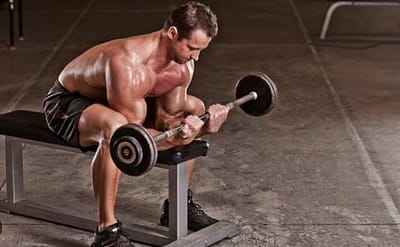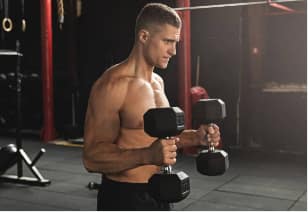 The part of the arm between the wrist and the elbow is called the forearm. It has two bones: the radius and the ulna. These bones join the elbow to the wrist. They are in line with each other. The forearm is a vital part of how the hand and wrist move, and it is also essential for strength and agility.
The part of the arm between the wrist and the elbow is called the forearm. It has two bones: the radius and the ulna. These bones join the elbow to the wrist. They are in line with each other. The forearm is a vital part of how the hand and wrist move, and it is also essential for strength and agility.
Anatomy of the Forearm:
- Ulna:
The ulna is one of the two bones in the forearm. It is on the inside (medial) side of the forearm. It goes farther and is bigger than the radius. The “funny bone” is the bony bump on the inside of the wrist that is made by the ulna.
- Radius:
The radius is the other bone in the forearm. It is on the outside (lateral) side of the wrist. It is shorter and smaller than the ulna. The radius runs from the elbow to the side of the wrist where the thumb is.
- Muscles of the Forearm:
The forearm is made up of various muscles, each with its own set of roles and movements. These muscles are in charge of the motions of the wrist, hand, and fingers. The following are some essential forearm muscles:
- Flexor Muscles:
These muscles, positioned on the inside side of the forearm, are in charge of flexing the wrist and fingers.
- Extensor Muscles:
These muscles extend the wrist and fingers and are positioned on the outside of the forearm.
Functions of the Forearm:
The forearm is required for a variety of daily actions and functions, including:
- Grip and Grasping:
The forearm muscles are essential for grip strength and gripping objects, allowing humans to hold and handle objects.
- Fine Motor Movements:
The forearm muscles govern precise motions of the fingers and hand, allowing for tasks such as writing, typing, and playing musical instruments.
- Rotation:
The forearm allows rotational motions of the hand and wrist, allowing tasks such as twisting a doorknob or using a screwdriver to be performed.
- Stability and Support:
The forearm stabilizes and supports the hand and wrist, assisting in actions requiring steadiness and control.
How to Work Out Forearms
- To work out your forearms efficiently, like with any other muscle group, you should do it at least twice a week on non-consecutive days.
- To maximum strength and muscular growth, perform three sets of 8-12 repetitions for each of the following exercises.
Dumbbell Wrist Flexion
How to do it:
- Place your right forearm on your right thigh, with the back of your right wrist on top of your right kneecap, and sit on the edge of a bench or chair with a dumbbell in your right hand.
- Lower the dumbbell as far as you can with just your hand, keeping a firm hold throughout the action.
- Curl the dumbbell up toward your bicep without raising your arm off your thigh, then gently drop the weight down to neutral.
- Repeat until exhausted, then switch sides and execute equal repetitions on each.
Benefits: Don’t be deceived by how easy this move sounds — this simple motion helps target and strengthen your wrist flexors, which are crucial in building grip strength.
Dumbbell Wrist Extension
How to do it:
- Sit on the edge of a bench or chair holding a dumbbell in your right hand, and place your right forearm on your right thigh, palm down, with your right wrist on top of your right kneecap.
- Without lifting your arm off your thigh, curl the dumbbell up as far as you can towards your bicep, maintaining a tight grip throughout the movement.
- Slowly lower the dumbbell back to neutral.
- Repeat to fatigue, and then switch sides, performing equal reps on each.
Benefits: Be aware of how simple this action appears; it targets and strengthens your wrist flexors, which are essential in developing grip strength.
Pull-Up Bar Hang
How to do it:
- Grab a pull-up bar with your palms looking forward and your hands shoulder-width apart.
- Hang with your arms straight and your legs crossed behind you for 30 seconds.
Benefits: This physical exercise builds your wrist and finger flexors and prepares you for scapular pull-ups and other types of pull-ups.
Inverted Row
How to do it:
- Please set up a Smith machine or power rack with a bar at waist height and lay on the floor underneath it.
- Hang from the bar with your arms fully stretched and your body straight from your head to your feet. Your shoulders should be right where your hands are, and your heels should be the same distance apart as your hips. This is where things begin.
- As you pull your chest to the bar and squeeze your shoulder blades together, keep your core tight.
Benefits: The inverted row strengthens the forearms while also targeting the shoulders and upper back muscles.
Hammer Curl:
How to do it:
- Holding a pair of dumbbells at arm’s length at your sides, palms facing each other, stand.
- Curl the dumbbells as near to your shoulders as you can while keeping your elbows tucked, upper arms locked (just your hands and forearms should move), and palms facing inward.
- After a little pause, steadily drop the weights back to their starting position.
Benefits: If classic biceps curls are your go-to, try this variant to change up your muscle stimuli. The neutral grip distributes part of the work to the forearm, but you’ll still get an excellent upper-arm exercise.
Standing Wrist Curls:
- This exercise is your best chance for exercising and strengthening the forearm flexors on the anterior side.
- Just hold a bar behind your back, let it drop down to your fingertips by spreading your fingers, and then curl your fingers and arms up to bring the weight back up.
- Since bending the finger and the wrist are both essential movements of the forearm flexors, doing them both at the same time will help the contraction.
- As you get stronger, you can use a more extensive bar and move on.
- I like this exercise better than wrist curls on a bench because it takes less wrist movement and puts less stress on the wrist joint, which is usually weak.
- If you tend to hurt your wrists, I suggest only doing this exercise.
Nutrition and Recovery:
- Make sure you eat a well-balanced diet that is high in protein and other necessary foods to help your muscles grow and heal.
- Give your muscles enough time to rest and heal between workouts for the best muscle growth.
- To build both size and strength in your wrists, you need to be consistent, use a suitable form, and move slowly.
- Add these workouts to your routine and keep track of your progress to see significant changes over time.



